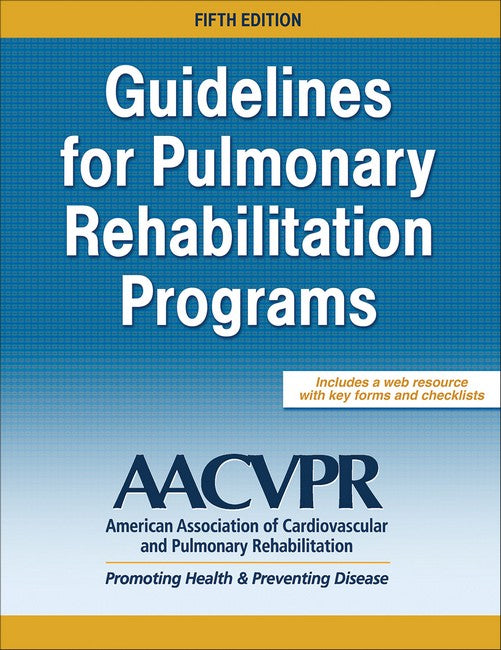The American Association of Cardiovascular and Pulmonary Rehabilitation (AACVPR) is dedicated to improving the quality of life for patients and their families by reducing morbidity, mortality, and disability from cardiovascular and pulmonary disease through education, prevention, rehabilitation, research, and disease management. AACVPR is a multidisciplinary professional association composed of health professionals who serve in the field of cardiac and pulmonary rehabilitation. AACVPR also provides educational and professional development opportunities to its members, including cardiovascular and pulmonary physicians, nurses, exercise physiologists, physical therapists, behavioral scientists, respiratory therapists, and nutritionists.
Request Academic Copy
Please copy the ISBN for submitting review copy form
Description
Chapter 1. Overview of Pulmonary Rehabilitation Brian Carlin Definition Rationale for Pulmonary Rehabilitation Pulmonary Rehabilitation and Integrated Care of the Respiratory Patient History of Pulmonary Rehabilitation Evidence-Based Guidelines on Pulmonary Rehabilitation Positioning Pulmonary Rehabilitation within the GOLD 2017 Guidelines Current Status of Pulmonary Rehabilitation Summary Chapter 2. Selecting and Assessing the Pulmonary Rehabilitation Candidate Gerilynn Connors and James Lamberti Patient Selection Patient Assessment Summary Chapter 3. Exercise Assessment and Training Chris Garvey, Rebecca Crouch, and Dave Verrill Rationale for Exercise Training in Chronic Lung Disease Mechanisms of Exercise Intolerance in Chronic Respiratory Disease Exercise Assessment Field Tests (Walking Tests) Graded Exercise Test and Cardiopulmonary Exercise Tests Functional Performance Assessment Exercise Prescription Volume, Pattern, and Progression of Exercise Training Resistance Exercise Testing Other Tests of Muscular Fitness Inspiratory Muscle Training Flexibility Training Patient Safety Precautions in Pulmonary Hypertension Exercise Induced Hypoxemia Home Exercise Considerations Emergency Procedures Documentation of the Evaluation and Treatment Session Summary Chapter 4. Collaborative Self-Management and Education Gerene Bauldoff, Jane Knipper, and Debbie Koehl Developing an Individualized Self-Management Program Implementing Self Management Training Summary Chapter 5. Psychosocial Assessment and Intervention Maria Buckley and Kent Eichenauer Assessment of Psychosocial Functioning Interventions to Improve Psychosocial Functioning Partnering with a Psychosocial Provider Summary Chapter 6. Nutritional Assessment and Intervention Ellen Aberegg Compromised Nutritional Status in Pulmonary Disease Diet Intake and COPD Assessment of Nutritional Status Nutrition Support Summary Chapter 7. Patient-Centered Evidence-Based Outcomes Gerene Bauldoff and Eileen Collins Timing and Analyzing Outcomes Patient-Centered Outcome Measures Summary Chapter 8. Disease-Specific Approaches to Pulmonary Rehabilitation Charlotte Tenebeck, Katherine Mensons, Jonathan Raskin, and Brian Carlin Restrictive Lung Diseases Pulmonary Hypertension Other Pulmonary Rehabilitation Populations Summary Chapter 9. Program Management and Reimbursement Realities Trina Limberg, June Schulz, and Karen Lui Interdisciplinary Team Program Content and Structure Administrative Aspects of Program Management Postrehabilitation Maintenance Reimbursement Realities Strategies for Program Success Summary Chapter 10. Putting It All Together: Performance Measures, Outcomes, Valid and Reliable Tools, and Program Certification Anne Gavic and Steve Lichtman Measuring the Quality of Patient Care AACVPR Outpatient Pulmonary Rehabilitation Registry Pulmonary Rehabilitation Certification Summary Appendix A: Forms, Questionnaires, Assessments, and Individualized Treatment Plan Example Appendix B: Excerpt from ATS/ERS Statement: Key Concepts and Advancements in Pulmonary Rehabilitation Appendix C: Clinical Competency Guidelines for Pulmonary Rehabilitation Professionals Appendix D: Example of Typical Pulmonary Rehabilitation Facility and Program Schedules Appendix E: Summary of Additional Recommended Guidelines for Pulmonary Rehabilitation
"This book continues to be the bible for evidence-based pulmonary rehabilitation programs." -Doody's Book Review (Four-Star Review)

